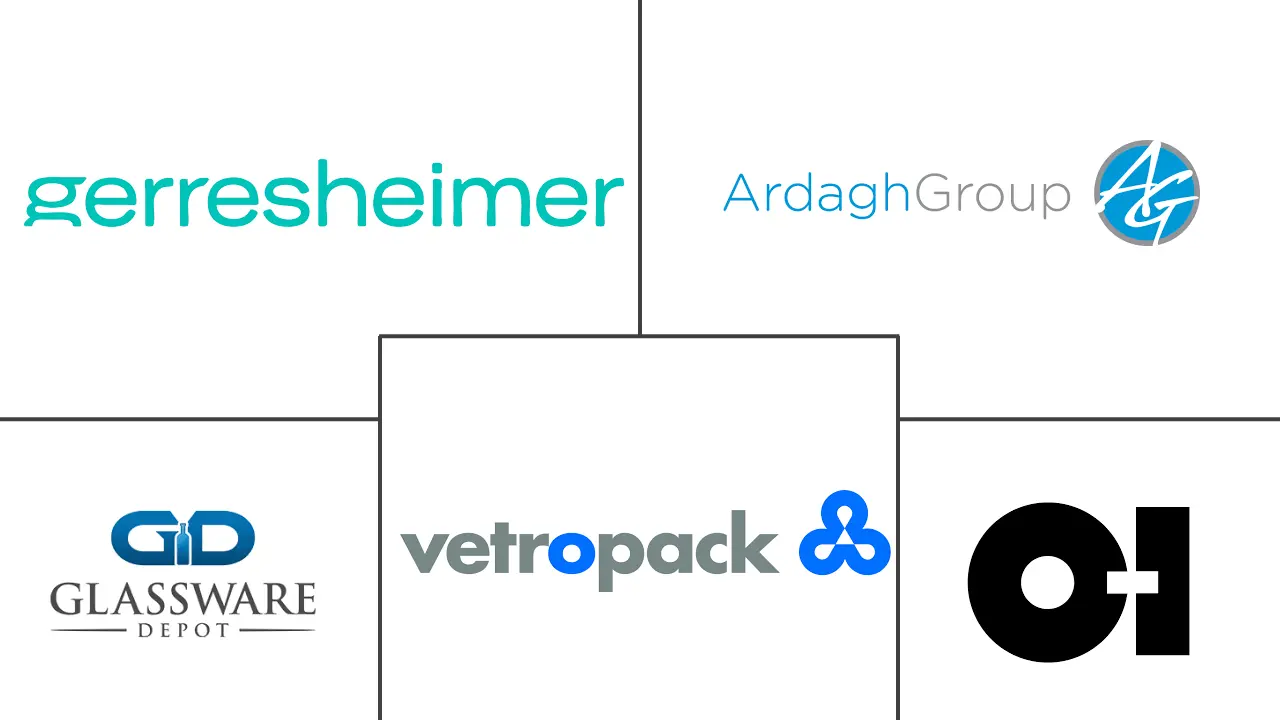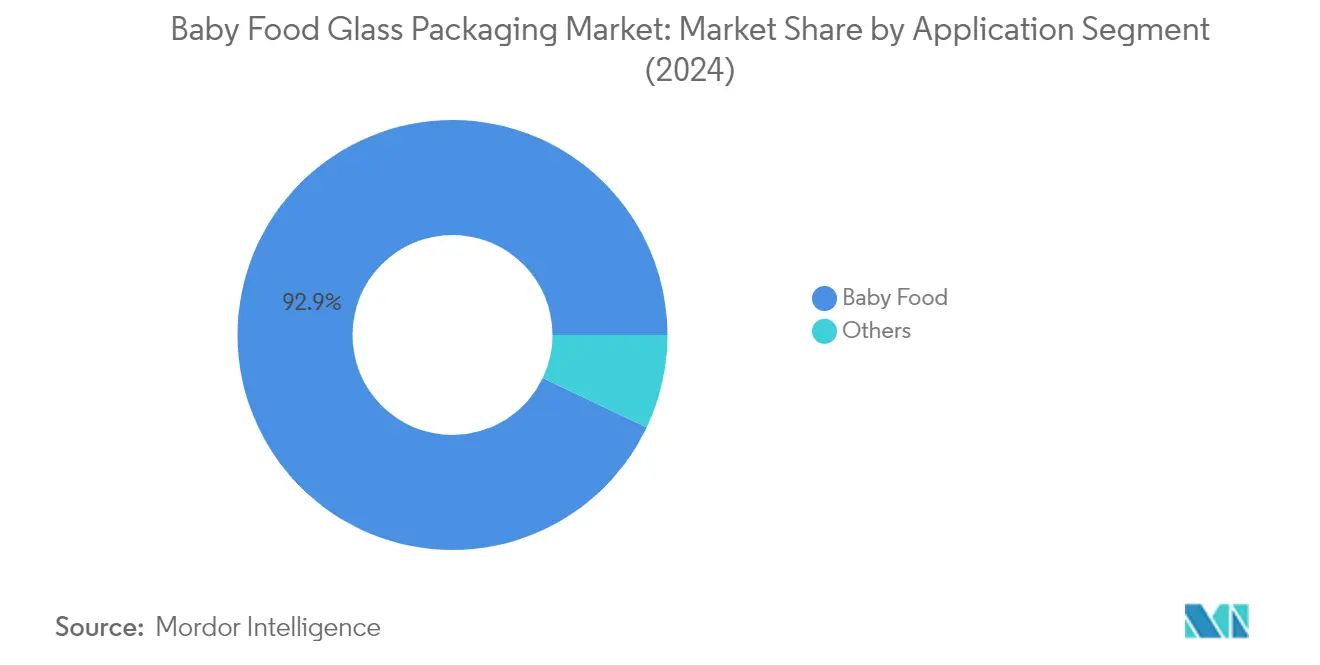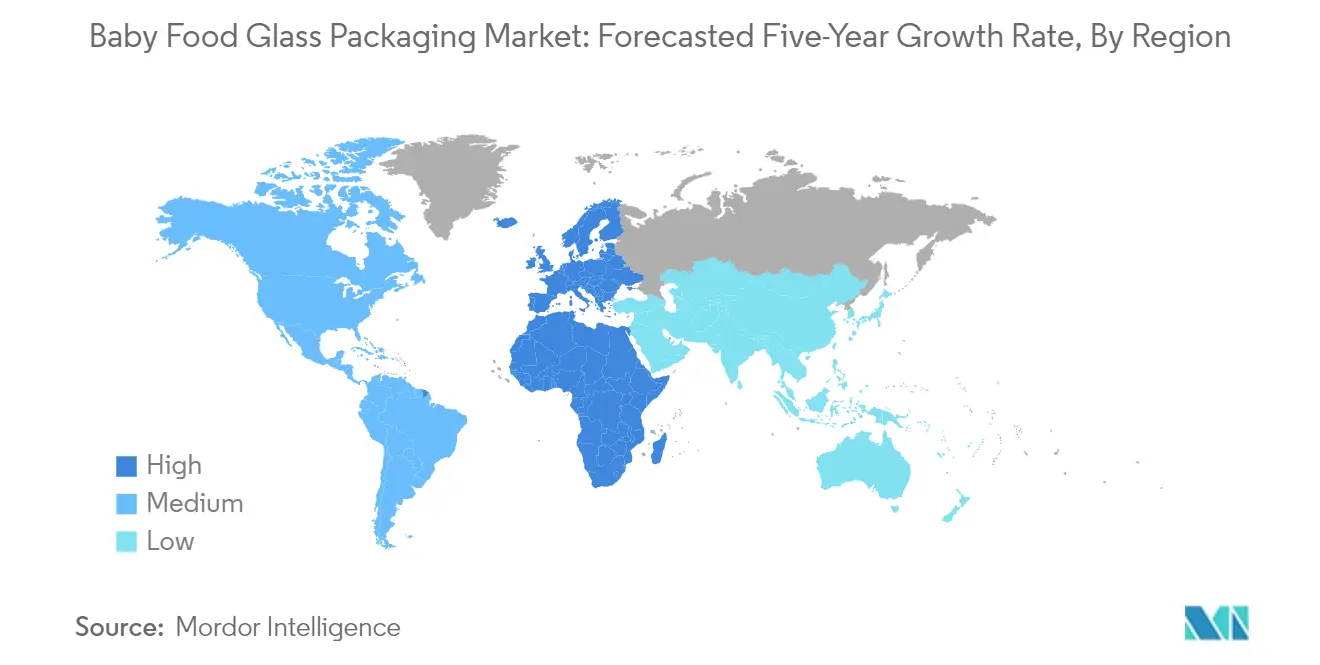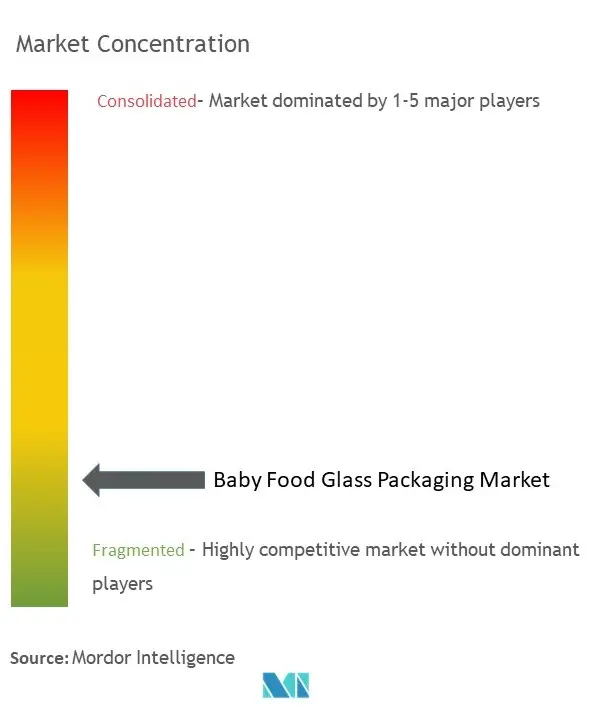
| Study Period | 2019 - 2030 |
| Market Size (2025) | USD 18.77 Million |
| Market Size (2030) | USD 22.85 Million |
| CAGR (2025 - 2030) | 4.01 % |
| Fastest Growing Market | Europe |
| Largest Market | Asia Pacific |
| Market Concentration | Low |
Major Players
*Disclaimer: Major Players sorted in no particular order |
Baby Food Glass Packaging Market Analysis
The Baby Food Glass Packaging Market size is worth USD 18.77 Million in 2025, growing at an 4.01% CAGR and is forecast to hit USD 22.85 Million by 2030.
The baby food glass packaging industry is experiencing significant transformation driven by increasing environmental consciousness and stricter safety standards. According to the Glass Packaging Institute (GPI), empty glass container production in the US has increased by approximately 288 million containers through August 2023, indicating a strong shift towards glass packaging solutions. This surge in production capacity has strengthened the North American supply chain, with Mexico emerging as the world's largest importer of glass bottles and jars. The industry is witnessing substantial investments in sustainable manufacturing processes, with major players implementing innovative technologies to reduce carbon emissions and improve production efficiency.
Safety and quality considerations continue to shape industry dynamics, particularly as concerns about microplastic contamination from alternative packaging materials grow. Scientific studies have revealed that bottle-fed infants are ingesting millions of microplastic particles daily, primarily due to the high-temperature sterilization procedures required for plastic bottles. The United Kingdom's glass packaging sector has demonstrated strong environmental credentials, achieving a robust recycling rate of 74.2% in 2023, one of the highest globally for any packaging material. This achievement has reinforced glass food storage as a preferred choice for safety-conscious parents.
Technological advancements in glass packaging manufacturing are revolutionizing the industry landscape. In Germany, glass packaging deliveries increased by 5.4% in 2022, according to the Federal Association of the German Glass Industry, demonstrating the sector's growth potential. Manufacturers are investing in advanced technologies such as vacuum-sealing and airtight lids to extend product shelf life without preservatives. These innovations are particularly crucial for organic and natural baby food products, where maintaining product integrity and freshness is paramount.
The regulatory environment continues to evolve, with authorities implementing stricter standards for baby food packaging materials. The European Food Safety Authority's 2023 scientific opinion on BPA has led to its classification as a reproductive toxicant, prompting increased scrutiny of plastic packaging alternatives. Glass manufacturers are responding by developing new solutions that not only meet these regulatory requirements but also address environmental concerns through reduced emissions and improved resource efficiency. Major industry players are investing in groundbreaking technologies, such as hybrid furnaces and modular glass melting systems, to achieve sustainability goals while maintaining product quality and safety standards.
Baby Food Glass Packaging Market Trends
PLASTICS CONTINUE TO RECORD STRONGER GROWTH COMPARED TO GLASS CONTAINERS
The plastic packaging segment continues to demonstrate robust growth in the baby food sector, primarily driven by its cost-effectiveness and practical advantages. Plastic is increasingly preferred for baby food packaging due to its energy-efficient manufacturing process and lighter weight compared to alternative materials. This trend is particularly evident in the baby formula segment, where single-serve plastic sachets have gained popularity among busy working parents. Recent innovations in plastic packaging technology have further strengthened this trend, with companies like Little Freddie launching recyclable baby food pouches with OPRL labels for home recycling in July 2022.
However, scientific research has raised significant concerns about plastic packaging safety. A 2023 study from the University of Nebraska-Lincoln revealed that plastic baby pouches emit substantial amounts of microplastic particles when heated in microwave ovens. These findings have highlighted potential chemical leaching issues that can affect food quality and safety. Glass food storage, in contrast, offers superior benefits including longer shelf life, complete sanitization capabilities, and the absence of chemical leaching risks. According to studies by Cherub Baby, glass food container is considered environmentally superior to plastic, using fewer resources and energy while offering infinite recyclability without quality degradation.
OVERALL GROWTH IN DEMAND FOR ORGANIC AND NATURAL BABY FOODS AND INNOVATIONS IN BABY FOOD PACKAGING
The organic and natural baby food segment is experiencing substantial growth, driven by increasing parental awareness and higher disposable incomes. This trend is particularly evident in both developed and developing markets, where parents are increasingly willing to pay premium prices for organic baby food products. The market has witnessed significant innovation in this space, exemplified by Tiny Organics' launch of the first non-puree product in the baby food category developed for baby-led weaning (BLW) in February 2022. This product line includes six meal offerings with various textures and easy-to-grasp cut sizes, specifically designed for children aged 4-8 months.
The industry is responding to this demand with innovative packaging solutions that align with organic and natural product positioning. Major players like Gerber have launched new plant-based baby food ranges, such as Plant-tastic, which has been certified as carbon neutral by the Carbon Trust. The packaging innovations extend beyond material selection to include comprehensive product information delivery systems. For instance, in December 2022, Plum Organics updated its packaging with a unique flavor scale paired with QR codes, making it easier for parents to navigate profiles and taste expectations without trial-and-error guesswork. These innovations reflect the industry's commitment to meeting consumer demands for transparency, sustainability, and product quality assurance.
Segment Analysis: By Application
Baby Food Segment in Baby Food Glass Packaging Market
The baby food segment dominates the baby food glass packaging market, accounting for approximately 93% of the total market share in 2024. This significant market share can be attributed to the increasing preference for glass food storage in baby food products due to its safety, recyclability, and ability to preserve food quality. Glass jar packaging with P/T seals has proven highly effective for preserving pasteurized or sterilized baby food, ensuring protection from microbial spoilage and oxidation while allowing products to remain unrefrigerated for extended periods. The segment's growth is further driven by the rising consumer awareness about the potential risks of plastic packaging, particularly concerning microplastic contamination in baby food products. Glass food containers allow consumers to see the product inside, providing reassurance about quality and freshness, which is particularly important for organic and natural baby food products. Advanced packaging technologies, such as vacuum-sealing and airtight lids, are being increasingly adopted to extend the shelf life of baby food in glass food storage without the need for preservatives. The segment is expected to maintain its dominant position through 2029, growing at approximately 4% annually from 2024 to 2029, driven by the increasing demand for sustainable packaging solutions and stricter regulations on food safety.

Other Applications Segment in Baby Food Glass Packaging Market
The other applications segment, which includes liquid milk formula and powder milk formula, represents a smaller but significant portion of the baby food glass packaging market. Glass food containers in this segment are particularly valued for their ability to maintain the freshness and quality of both liquid and powdered formulas. Glass jar packaging and bottles provide excellent barriers against oxygen and moisture, which are crucial factors in preventing product spoilage and maintaining nutritional value. The segment benefits from the growing awareness among parents about the potential risks associated with plastic packaging, particularly concerning chemical leaching during sterilization and preparation processes. Glass containers in this segment are preferred for their inert properties, ensuring that no chemicals react with or contaminate the formula, thereby maintaining its safety and purity throughout its shelf life.
Baby Food Glass Packaging Market Geography Segment Analysis
Baby Food Glass Packaging Market in North America
The North American glass packaging market for baby food demonstrates strong growth potential, driven by increasing consumer awareness about sustainable packaging solutions and a growing preference for chemical-free storage options. The United States and Canada represent the key markets in this region, with manufacturers focusing on innovative glass jar packaging solutions that meet stringent safety standards while providing convenience to parents. The region's market is characterized by strong distribution networks, established retail channels, and growing e-commerce penetration for baby food products.

Baby Food Glass Packaging Market in United States
The United States dominates the North American market as the largest country by market size, holding approximately 84% share of the regional market in 2024. The country's market is driven by increasing awareness of the harmful effects of plastic packaging and growing demand for premium baby food products. American parents are increasingly gravitating towards glass packaging due to its non-toxic nature and ability to preserve food quality. The presence of major glass packaging manufacturers and baby food companies, coupled with a strong regulatory framework supporting food safety, further strengthens the market position of glass packaging in the baby food segment.
Baby Food Glass Packaging Market in Canada
Canada emerges as the fastest-growing market in North America, with a projected growth rate of approximately 5% during 2024-2029. The growth is attributed to increasing environmental consciousness among Canadian consumers and rising demand for organic baby food products. The country's robust recycling infrastructure and government initiatives promoting sustainable packaging solutions provide a favorable environment for glass food container adoption. Canadian manufacturers are increasingly investing in eco-friendly packaging solutions, with glass containers gaining prominence in the baby food segment.
Baby Food Glass Packaging Market in Europe
The European market for baby food glass packaging showcases strong growth potential, driven by stringent regulations on plastic packaging and increasing environmental awareness. The region encompasses key markets, including Germany, the United Kingdom, France, and Spain, each contributing significantly to the overall market dynamics. European consumers demonstrate a strong preference for sustainable packaging solutions, with glass packaging benefiting from its recyclability and premium image in the baby food segment.
Baby Food Glass Packaging Market in Germany
Germany leads the European market as the largest country by market size, commanding approximately 17% of the regional market in 2024. The country's strong position is supported by its robust glass packaging manufacturing infrastructure and high consumer awareness regarding sustainable packaging solutions. German parents increasingly prefer glass jar packaging for baby food products due to its safety features and environmental benefits. The presence of major glass packaging manufacturers and their continuous investment in innovative solutions further strengthens Germany's market position.
Baby Food Glass Packaging Market in Germany
Germany also emerges as the fastest-growing market in Europe, with a projected growth rate of approximately 6% during 2024-2029. This growth is driven by increasing adoption of premium baby food products and rising environmental consciousness among German consumers. The country's strong focus on circular economy principles and government support for sustainable packaging solutions creates favorable conditions for market expansion. German manufacturers continue to innovate in glass packaging technology, introducing lighter and more convenient solutions while maintaining the material's core benefits.
Baby Food Glass Packaging Market in Asia-Pacific
The Asia-Pacific region represents a significant market for baby food glass packaging, characterized by diverse consumer preferences and varying levels of market maturity across countries. Key markets include China, Japan, and India, each contributing uniquely to the regional market dynamics. The region's growth is driven by increasing urbanization, rising disposable incomes, and growing awareness about food safety among parents.
Baby Food Glass Packaging Market in China
China dominates the Asia-Pacific market as the largest country by market size. The Chinese market benefits from its large consumer base and increasing preference for premium baby food products. Rising concerns about food safety and growing environmental consciousness among Chinese parents drive the demand for glass packaging in the baby food segment. The country's robust manufacturing capabilities and presence of major glass packaging manufacturers further support market growth.
Baby Food Glass Packaging Market in Japan
Japan emerges as a key market with significant growth potential in the Asia-Pacific region. The Japanese market is characterized by high-quality standards and strong consumer preference for safe packaging solutions. Japanese manufacturers focus on innovative glass packaging designs that combine safety with convenience. The country's strong recycling infrastructure and consumer awareness about environmental sustainability create favorable conditions for market growth.
Baby Food Glass Packaging Market in Middle East & Africa
The Middle East & Africa region demonstrates growing potential in the baby food glass packaging market, driven by increasing urbanization and rising awareness about food safety. The market benefits from growing disposable incomes and changing consumer preferences towards premium packaging solutions. Saudi Arabia emerges as the largest market in the region, while the United Arab Emirates shows the fastest growth potential, supported by strong retail infrastructure and increasing demand for premium baby food products.
Baby Food Glass Packaging Market in Latin America
The Latin American market for baby food glass packaging shows promising growth potential, driven by increasing awareness about sustainable packaging solutions and rising demand for premium baby food products. The region benefits from growing urbanization and rising disposable incomes, particularly in major economies. Brazil emerges as the largest market in the region, while Mexico demonstrates the fastest growth potential, supported by strong manufacturing capabilities and increasing consumer awareness about food safety.
Baby Food Glass Packaging Market Overview
Top Companies in Baby Food Glass Packaging Market
The baby food glass packaging market features established players like O-I Glass, Gerresheimer AG, Vetropack Holding, Ardagh Group, and SGD Pharma leading the industry through continuous innovation and strategic expansion. Companies are increasingly focusing on developing sustainable and eco-friendly glass packaging solutions, with emphasis on recyclability and reduced carbon footprints. The industry witnesses ongoing investments in advanced manufacturing technologies and automation to improve production efficiency and product quality. Market leaders are strengthening their positions through strategic partnerships and collaborations with baby food manufacturers, while also expanding their geographical presence through targeted acquisitions and facility expansions. Product innovation trends include the development of lightweight glass food containers, enhanced safety features, and customizable design options to meet evolving consumer preferences and regulatory requirements.
Consolidated Market with Strong Regional Players
The baby food glass packaging industry exhibits a relatively consolidated structure, dominated by large multinational corporations with established manufacturing capabilities and extensive distribution networks. These major players leverage their technological expertise, research and development capabilities, and economies of scale to maintain their competitive advantage. Regional players maintain significant market presence in their respective territories through strong relationships with local baby food manufacturers and an understanding of regional preferences. The market has witnessed several strategic mergers and acquisitions aimed at expanding geographical reach, enhancing production capabilities, and accessing new customer segments.
The competitive landscape is characterized by high entry barriers due to substantial capital requirements, stringent quality standards, and the need for specialized manufacturing expertise. Market leaders continue to strengthen their positions through vertical integration strategies, controlling various aspects of the supply chain from raw material procurement to distribution. The industry also sees increasing collaboration between glass packaging manufacturers and baby food companies to develop innovative packaging solutions that address specific market needs and consumer preferences. This collaborative approach has become crucial for maintaining competitive advantage and ensuring long-term success in the market.
Innovation and Sustainability Drive Future Success
Success in the baby food glass packaging industry increasingly depends on companies' ability to innovate while maintaining high safety standards and environmental sustainability. Market incumbents must focus on developing advanced manufacturing processes that reduce production costs while maintaining product quality, alongside investing in research and development to create differentiated packaging solutions. Companies need to strengthen their sustainability credentials through initiatives such as increased use of recycled glass, reduced energy consumption, and implementation of circular economy principles. Building strong relationships with baby food manufacturers through collaborative product development and customization capabilities has become essential for maintaining market position.
For new entrants and smaller players, success lies in identifying and serving niche market segments with specialized packaging solutions while building a strong regional presence. Companies must navigate increasingly stringent regulations regarding food safety and environmental impact, making compliance capabilities a critical success factor. The threat of substitution from alternative packaging materials necessitates continuous innovation in glass food packaging design and functionality to maintain market share. Future success also depends on companies' ability to adapt to changing consumer preferences, particularly regarding convenience features and environmental sustainability, while maintaining cost competitiveness through operational efficiency and strategic sourcing relationships.
Baby Food Glass Packaging Market Leaders
-
O-I Glass Inc.
-
Gerreshmier AG
-
Vetropack Holding Ltd
-
Glassware Depot
-
Ardagh Group S.A.
- *Disclaimer: Major Players sorted in no particular order

Baby Food Glass Packaging Market News
- September 2023 - Ardagh Glass Packaging revealed its plan to build a highly sustainable furnace at its Obernkirchen facility to minimize greenhouse gas emissions. The NextGen furnace is expected to commence production of commercial glass containers by the end of 2023 with the capacity to produce up to 350 tonnes (t) of glass bottles per day.
- May 2023 - Ardagh Glass GmbH, part of Ardagh Glass Packaging (AGP), began building a groundbreaking hybrid furnace to facilitate a switch to renewable electricity at its glass production facility in Germany. The technology in the appropriately named 'NextGen' furnace significantly reduces CO2 emissions by as much as 60% in the furnace. The company considers this an essential step in gaining the emissions target of the company's 2030 Sustainability Strategy.
Baby Food Glass Packaging Market Report - Table of Contents
1. INTRODUCTION
- 1.1 Study Assumptions and Market Definition
- 1.2 Scope of the Study
2. RESEARCH METHODOLOGY
3. EXECUTIVE SUMMARY
4. MARKET INSIGHTS
- 4.1 Market Overview
- 4.2 Industry Attractiveness - Porter's Five Forces Analysis
- 4.3 Industry Ecosystem Analysis
5. MARKET DYNAMICS
-
5.1 Market Drivers
- 5.1.1 Plastics Continue to Record Stronger Growth Compared to Glass Containers
- 5.1.2 Overall Growth in Demand for Organic and Natural Baby Foods and Innovations in Baby Food Packaging
-
5.2 Market Restraints
- 5.2.1 Issues Related Material Regulations
- 5.3 Summary of Baby Food Industry with Geographical Trends
- 5.4 Industry Regulations and Standards
- 5.5 Relative Demand Analysis of Major Material Types Glass, Plastic, Paperboard and Metal
- 5.6 Role of Sustainability and Convenience in the Baby Food Packaging Industry
6. MARKET SEGMENTATION
-
6.1 By Application
- 6.1.1 Baby Food
- 6.1.2 Other Applications
-
6.2 By Geography
- 6.2.1 North America
- 6.2.1.1 United States
- 6.2.1.2 Canada
- 6.2.2 Europe
- 6.2.2.1 Germany
- 6.2.2.2 United Kingdom
- 6.2.2.3 France
- 6.2.2.4 Spain
- 6.2.3 Asia
- 6.2.3.1 China
- 6.2.3.2 Japan
- 6.2.3.3 India
- 6.2.3.4 Australia and New Zealand
- 6.2.4 Middle East and Africa
- 6.2.5 Latin America
7. MARKET SEGMENTATION - BABY GLASS BOTTLES (NURSING/FEEDING)
-
7.1 By Geography
- 7.1.1 North America
- 7.1.1.1 United States
- 7.1.1.2 Canada
- 7.1.2 Europe
- 7.1.2.1 Germany
- 7.1.2.2 United Kingdom
- 7.1.2.3 France
- 7.1.2.4 Spain
- 7.1.3 Asia
- 7.1.3.1 China
- 7.1.3.2 Japan
- 7.1.3.3 India
- 7.1.3.4 Australia and New Zealand
- 7.1.4 Middle East and Africa
- 7.1.5 Latin America
8. COMPETITIVE LANDSCAPE
-
8.1 Company Profiles*
- 8.1.1 O-I Glass Inc.
- 8.1.2 Gerreshmier AG
- 8.1.3 Vetropack Holding Ltd
- 8.1.4 Ardagh Group S.A.
- 8.1.5 Glassware Depot
- 8.1.6 SGD SA (SGD Pharma)
- 8.1.7 Pigeon Corporation
- 8.1.8 Mayborn Group Limited
- 8.1.9 Evenflo Feeding
- 8.1.10 Sundelight Infant Products Ltd
9. FUTURE OUTLOOK OF THE MARKET
Baby Food Glass Packaging Market Industry Segmentation
Glass packaging is often preferred for baby food as it is impermeable and nonporous. Thus, there is no interaction between the glass packaging and the products to alter the taste of baby food. There is no unpleasant aftertaste as well. Glass has a near-zero rate of chemical reactions, which ensures that the products contained within a glass bottle maintain their potency, aroma, and taste.
The baby food glass packaging market is segmented by application (baby food and other applications) and geography (North America [United States and Canada], Europe [Germany, United Kingdom, France, Spain, and the Rest of Europe], Asia-Pacific [China, Japan, India, and Rest of Asia-Pacific] Middle East & Africa, and Latin America). The study also includes the baby glass bottles market, segmented by geography: North America [United States and Canada], Europe [Germany, United Kingdom, France, Spain, and the Rest of Europe], Asia-Pacific [China, Japan, India, and Rest of Asia-Pacific] and the Rest of world. The report offers the market size in terms of value USD for all the above segments.
| By Geography | North America | United States | |
| Canada | |||
| Europe | Germany | ||
| United Kingdom | |||
| France | |||
| Spain | |||
| Asia | China | ||
| Japan | |||
| India | |||
| Australia and New Zealand | |||
| Middle East and Africa | |||
| Latin America | |||
Baby Food Glass Packaging Market Research FAQs
How big is the Baby Food Glass Packaging Market?
The Baby Food Glass Packaging Market size is worth USD 18.77 million in 2025, growing at an 4.01% CAGR and is forecast to hit USD 22.85 million by 2030.
What is the current Baby Food Glass Packaging Market size?
In 2025, the Baby Food Glass Packaging Market size is expected to reach USD 18.77 million.
Which is the fastest growing region in Baby Food Glass Packaging Market?
Europe is estimated to grow at the highest CAGR over the forecast period (2025-2030).
Which region has the biggest share in Baby Food Glass Packaging Market?
In 2025, the Asia Pacific accounts for the largest market share in Baby Food Glass Packaging Market.
What years does this Baby Food Glass Packaging Market cover, and what was the market size in 2024?
In 2024, the Baby Food Glass Packaging Market size was estimated at USD 18.02 million. The report covers the Baby Food Glass Packaging Market historical market size for years: 2019, 2020, 2021, 2022, 2023 and 2024. The report also forecasts the Baby Food Glass Packaging Market size for years: 2025, 2026, 2027, 2028, 2029 and 2030.
Our Best Selling Reports
Baby Food Glass Packaging Market Research
Mordor Intelligence offers comprehensive industry analysis and market outlook for the glass packaging market and glass baby bottle market, providing stakeholders with detailed insights into market size, growth trends, and competitive dynamics. Our research methodology combines extensive primary and secondary research, offering a thorough understanding of the glass food container and glass packaging industry landscape. The report pdf includes detailed market segmentation, technology trends, and strategic insights that help businesses make informed decisions in the food glass packaging space, particularly focusing on safety regulations and consumer preferences in the infant food packaging segment.
Our consulting expertise extends beyond traditional market research, offering specialized services in regulatory assessment and product safety compliance crucial for glass jar packaging manufacturers. We provide in-depth analysis of consumer behavior patterns, helping companies understand evolving parent preferences and safety concerns in the glass food storage sector. Our team assists clients with new product launch strategies, product claims assessment, and competition assessment, ensuring successful market entry and growth. Through advanced data analytics and visualization techniques, we help stakeholders identify emerging opportunities and optimize their market positioning in this sensitive consumer segment, with all insights available in an easy-to-download report pdf format.




